Meet "Farmer Bob" Hines

Robert Hines looks over "the back 40"
Much has been written about the heritage of the Laboratory site. The local libraries, historical museums and societies contain material dating back to the early 1800's -- the Potawatomi Indians who first settled hear the "Big Woods," the early white settlers, information oh the nearby towns and farmlands inhabited by former and present residents.
What legacy will NAL leave for those who come to the area in another hundred years? Will the 200 BeV Accelerator, or a 500 BeV Accelerator, for which there is room for expansion, be as obsolete as the Indian arrowheads are today? Could these 6,800 acres be within the city limits of Chicago -- possibly the only vestige of rural living in this area? The possibilities of projection into the future are limitless for anyone interested in "playing the game."
Two Goals for NAL
Although the NAL goal is to create a hew center of technical and scientific excellence, an equally important goal is to preserve and perpetuate as much as possible of the area's natural resources.
One of the men responsible for carrying out the Laboratory's plans for preserving the natural resources of the Laboratory site is Robert L. Hines, NAL's Farm Manager, a former resident of Iowa, having received a Bachelor of Science Degree in Animal Science and an associate degree in Pre-Veterinary Medicine. With a background of twenty years in agricultural sales, a competitor in the judging of livestock and meat, winner of many blue ribbons at State and County Fairs all over the country for prize hereford, angus and shorthorn cattle, including several Grand Champions, Bob brings a true conservationist attitude to his position.
Site Plans
The existing fences around the individual former farms oh the NAL site will be removed. Many of the farm homes may be pres e r v e d for possible use as campus-associated housing. Farm areas will be seeded, with a limited amount of machine-mowing (possibly a herd of angus or herefords, or even buffalo, doing what comes naturally!) Except for several necessary access roads, there are ho plans for expressway-type highways to commercialize the area. Water catchment lakes, streams and reservoirs will be plentiful on the site. Some thought has been given to using a portion of the land for a model farm.
The former Village of Weston may sometime be used as a residential area for Laboratory visitors -- a neighborhood-type complex consisting of individual homes surrounding a beautiful lake with groves of trees and other landscaping to complement the village (honestly, no attempt is being made to duplicate the original "Big Woods.")
A nursery, to build up and maintain the overall landscaping, will be a long-term, perpetuating program to insure that the area will be maintained in a natural, park-like atmosphere. Planting around the Accelerator's Main Ring and the other scientific structures will blend into the existing landscape.
Historical Displays
NAL hopes to have an historical display of past and present memorabilia, probably housed in one of the beautiful large barns oh the site. The southwestern corner of the land might provide a recreation area, including picnic areas and a large lake (possibly encompassing 50 acres) for summer and winter sports. If the Midwest will provide the show, there may be a ski slope for the hardier "sports."
An interesting project how in the planning process for the summer of '69 is a Farmstead Day Camp for urban, suburban and rural young people to join in mind and skill-building activities. Although gardening on ten acres is the primary concern of this program, film-making, birdhouse-building, creek-wading and meadowbaseball, plant-naming, and bonfire-singing are also oh the schedule. It may well be that this group of youngsters, with a "back-to-nature" concept, will take the first step toward creating the attitude Bob Hines is seeking to establish as a conservation criterion for the Laboratory. Two-Fold Legacy
The preserving and improving of the presently-productive land will be a fitting legacy for NAL personnel to leave for future generations, along with the knowledge that the scientific progress the Laboratory will surely generate will be productive in improving men's minds, in creating hew ideas and in producing knowledge for many generations to come.
Bob Hines, farm manager, reports that 50 garden plots in the Village have been allocated to employees for their agrarian interests. The plots are 25 feet by 50 feet, have been plowed and are ready for planting.
The plots were gone within three days' time after their availability had been announced.
Hines said that most of the part-time gardeners plan to raise tomatoes, beans, squash, etc. Adjacent to each plot, he said, there are 12 rows of sweet corn which will be given free of charge to whoever has the lease on each plot.


